Technology disruptions in our world are becoming routine, and consumers are becoming impervious to the daily assault on their attention. In order to be effective, brand marketers need to rise above and beyond an ever-rising bar of campaign creativity, as well as use technology to break through all the noise that distracts their audiences. This means developing marketing that has high recall and is 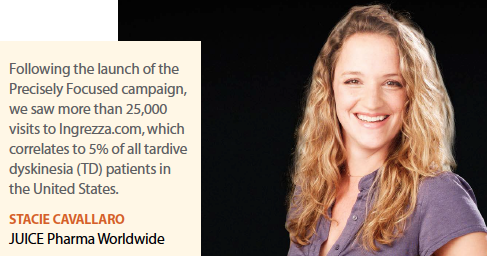 actionable, and includes a digital component to support and service consumers, whether the target audience is the physician or patient. Agencies are using new tools such as Facebook 360 video, virtual reality, and mobile apps to bring disruptive concepts and campaigns to the cautious world of health and life-science marketing.
actionable, and includes a digital component to support and service consumers, whether the target audience is the physician or patient. Agencies are using new tools such as Facebook 360 video, virtual reality, and mobile apps to bring disruptive concepts and campaigns to the cautious world of health and life-science marketing.
Eight agency executives, and in two cases, their clients, discuss how they created campaigns that broke the mold and effectively developed messaging that hit the mark in terms of audience and impact. In some instances, these campaigns have won industry awards across categories. Others campaigns are too new to have been submitted for judging.
One of the ways agencies are generating disruptive ideas is by taking cues from the consumer packaged goods and other industries.
According to Jonathan Cooper, senior VP director, content, PR & social, at LevLane, looking outside the industry is a great way to brainstorm for new ideas for that creative approach. The pharma industry needs to get as comfortable with using social, mobile, and technologies such as virtual reality (VR) as consumer-focused brands are.
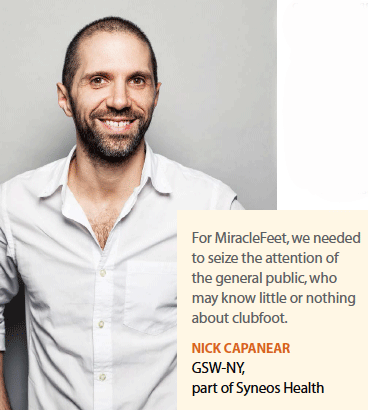 “We have clients that are willing to look beyond the industry norm; they realize that to reach their market and their consumers, they have to go outside the traditional means," Mr. Cooper says. “They know that the landscape will continue to shift very quickly and they want to be prepared for change."
“We have clients that are willing to look beyond the industry norm; they realize that to reach their market and their consumers, they have to go outside the traditional means," Mr. Cooper says. “They know that the landscape will continue to shift very quickly and they want to be prepared for change."
Mr. Cooper has observed more clients willing to use augmented reality and VR as it specifically relates to the patient journey. “The trick is to be able to provide new thinking, break away from the clutter, show how results can be generated, as well as engage healthcare professionals, family caregivers, and patients all along the journey," he says. Mr. Cooper and LevLane worked on the Recreating the Feeling campaign for Jefferson Comprehensive Concussion Center (JCCC), with the purpose of educating both doctors and patients about concussions and treatment. (See sidebar for more information on this campaign and other examples that follow.)
GSW-NY, part of Syneos Health, was tasked with the goal to raise awareness and funding for the little-known birth defect clubfoot. The agency created This Little Piggy campaign, offering its services pro bono to MiracleFeet, a charity to aid children in other countries who are born with the defect. Easily treatable in the United States, the defect often goes untreated in children born in developing countries.
“The campaign had to be aggressive and raw to be effective, as we needed to seize the attention of the general public who may know little or nothing at all about clubfoot," says Nick Capanear, executive 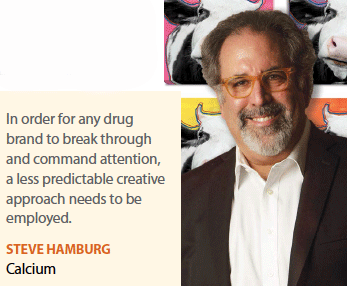 VP, executive creative director, GSW-NY. The campaign accomplished this by telling real-life stories of what happens to children born with these defects in other countries. “We rose above the noise by being truthful about the stories," Mr. Capanear says. “They’re tough to hear; very young children are living through horrific experiences all because of this birth defect. Sugar coating this disease does no one any favors. We needed people to understand the real effects of untreated clubfoot."
VP, executive creative director, GSW-NY. The campaign accomplished this by telling real-life stories of what happens to children born with these defects in other countries. “We rose above the noise by being truthful about the stories," Mr. Capanear says. “They’re tough to hear; very young children are living through horrific experiences all because of this birth defect. Sugar coating this disease does no one any favors. We needed people to understand the real effects of untreated clubfoot."
There are times when rising above the noise may mean integrating well within a lifestyle or patient journey, as opposed to being a disruptive presence.
For example, in partnership with AstraZeneca, Razorfish Health developed an app — ONCsultation — for oncology patients to better understand the conversations they have with their oncologists. And it was important that the app integrated seamlessly into the consultation experience.
“We knew technology would play a critical role in helping to find a solution, but it had to be almost invisible and serve as a vehicle for transforming a clinical conversation into an emotional connection between doctor and patient," says Josh Tumelty, executive VP, executive creative director, at Razorfish Health. “Our greatest learning was that sometimes disruptive communications are just as much about fitting in as they are about standing out. Sometimes, it’s about being a sense of calm in a sea of chaos."
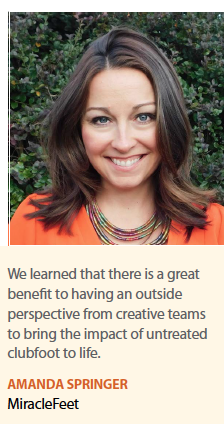 As clients become more interested in different ways to get their messages across, sometimes it takes rethinking familiar campaigns and how they can disrupt their audiences’ behavior and response to the message.
As clients become more interested in different ways to get their messages across, sometimes it takes rethinking familiar campaigns and how they can disrupt their audiences’ behavior and response to the message.
“We work with our clients every day to think about the opportunity to step outside of the traditional box and create campaigns that are more relatable to their target markets," says Tracey Cooper, digital engagement strategist, at Ogilvy CommonHealth Worldwide (OCHWW).
“The best example of this is our work with partner Genentech; we needed to disrupt how we traditionally think about stroke awareness," she says. “We wanted to encourage caregivers to call 911 the moment they suspect their loved one may be having a stroke."
The disease-awareness, mass-market media campaign, Overreact2stroke, focused on the emotional as well as educational aspects by taking the point of view of a person witnessing a stroke, as opposed to the person having the stroke.
The campaign gives people permission to do something immediately when they notice someone exhibiting stroke symptoms.
“The creative concept in our campaign honed in on giving caregivers and care partners permission to stop second guessing and start overreacting about stroke and inspire them to make all the difference by acting urgently and fearlessly, even if it seems to be an overreaction, so as not to lose any time getting their loved one to the ER for immediate medical attention," Ms. Cooper says.
Breaking the Mold
Advertising in general is only as strong as the insights, thinking, and creativity behind it. So, rather than worry unduly about “new versus old," it is better to never lose sight of the fundamentals, which 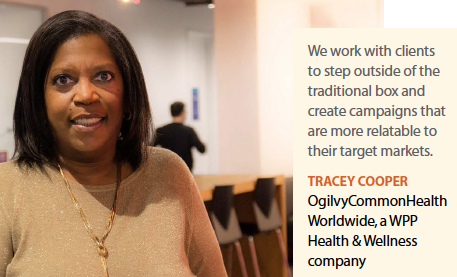 consist of an in-depth understanding of the audience and its needs, the brand and its performance, and the unique strategic position a brand can occupy within a marketplace.
consist of an in-depth understanding of the audience and its needs, the brand and its performance, and the unique strategic position a brand can occupy within a marketplace.
“New, more targeted advertising models and methods are relevant and important; but, there’s no substitute for getting the foundational thinking right," says Steve Hamburg, managing partner/chief creative officer, Calcium. The agency used an interesting twist within a commonly used format to bring brand disruption to the Keveyis for Primary Periodic Paralysis campaign.
In other cases, campaigns have addressed a pain point that needed to be addressed, and by using new tools such as video, social media, mobile apps, and new thinking, agencies and their clients are overcoming the biggest challenges and creating a concept that stands above the rest.
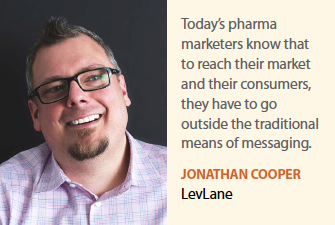 In the Overreact2stroke campaign, for example, OCHWW used a redesigned website to educate and drive awareness of acting with urgency in the event of stroke.
In the Overreact2stroke campaign, for example, OCHWW used a redesigned website to educate and drive awareness of acting with urgency in the event of stroke.
According to OCHWW, the average person usually thinks about how stroke affects someone else. They think they know the usual signs and symptoms if someone is having a stroke. Everyone has seen the FAST (Facial drooping, Arm weakness, Speech difficulties, and Time to call emergency services) signs up in their doctor’s office, a health website, or in a hospital. While educationally effective, it does not address the fact that the thought is that strokes happen to someone else and it does not bring to light other symptoms of stroke that people often miss.
“We worked with Anthony Atanasio, senior product manager, at Genentech, to look for a different approach — one that was more emotional and that targeted care partners and caregivers," Ms. Cooper says. “We wanted to activate individuals most likely to react to someone they care about who is having a stroke."
The campaign broke the mold by: raising awareness about the lesser-known subtle symptoms of stroke; speaking to how stroke may affect those you love, since those are the people you know best; 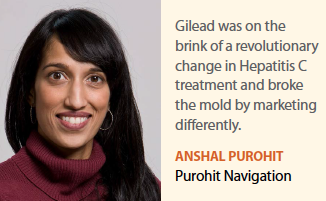 amplifying the sense of urgency and permission to act in getting someone — probably a loved one having a stroke — to the hospital; and targeting a specific demographic group.
amplifying the sense of urgency and permission to act in getting someone — probably a loved one having a stroke — to the hospital; and targeting a specific demographic group.
According to Mr. Atanasio, the campaign was a success due to this rethinking of the perspective of stroke.
“Using traditional research and insight gathering provides traditional answers," he says. “When trying to make a major innovation, we need to not only rethink the issue, but also the questions to ask when learning about the issue."
According to Mr. Atanasio, creating urgency around the recognition of symptoms, giving permission and encouragement to act, and focusing the education on the care partner is the innovation that is different — it broke the mold.
GSW-NY and MiracleFeet’s challenge was to convince a U.S.-based audience to care about an issue that primarily occurs far from where they live. MiracleFeet’s mission is to increase access to proper treatment for children born with clubfoot in low- and middle-income countries through partnerships with local healthcare providers. Clubfoot is a condition that is easily treated in the United States and higher income countries — however, the campaign had to bring home the true hardship clubfoot is for parents who do not have the means to correct their child’s impairment.
“The stories used made the audience take a second look and really pay attention," says Amanda 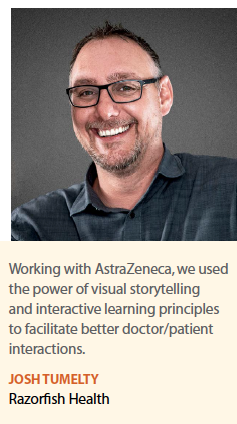 Springer, director of marketing and communications, MiracleFeet.
Springer, director of marketing and communications, MiracleFeet.
Juice Pharma and its client Neurocrine Biosciences are tackling tardive dyskinesia, or TD, a debilitating, embarrassing, and often-irreversible involuntary movement disorder caused by antipsychotic medications.
For decades, psychiatrists and neurologists had no FDA-approved treatment specifically indicated for their patients with TD. As a result, physicians have had limited options for managing TD, mainly adjusting patients’ dosages up or down or switching their treatment, always trying to find the right balance between psychiatric stability and TD.
Enter Ingrezza, launched in April 2017 by Neurocrine Biosciences as the first and only treatment specifically for treating tardive dyskinesia. This presented Juice Pharma with a welcome challenge: educate physicians and patients on the availability and need of treatment. All aspects of the campaign were designed to redefine physician’s perceptions of what it means to truly treat TD, from the clinically distinct movements of the disorder itself to now having an FDA-approved treatment with a novel and targeted mechanism of action.
“Called Precisely Focused, every aspect of the campaign seeks to disrupt a treatment space that had been all but abandoned," says Janeen Negherbon, VP, group copy supervisor, Juice Pharma Worldwide. “Precisely Focused gives Ingrezza a voice, one that echoes in the hearts and minds of patients and physicians alike because for the first time ever, there’s finally a brand that can speak their language, one that knows TD and its very real impact."
Moving from lack of treatment to lack of awareness, the next campaign, led by Purohit Navigation, had to overcome physicians’ misconception that Hepatitis C (HCV) couldn’t be cured. Through research, Purohit discovered there were primary care physicians who didn’t know that there was a cure for HCV. As a result, they didn’t always screen at-risk patients or refer infected patients for treatment. This placed many patients, who had been living with the disease for more than 20 years, at 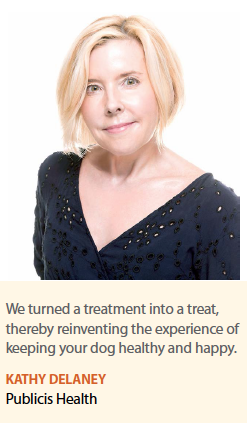 risk for cirrhosis or liver cancer. What Purohit Navigation had to do was motivate these physicians to screen for HCV and ensure that infected patients receive treatment.
risk for cirrhosis or liver cancer. What Purohit Navigation had to do was motivate these physicians to screen for HCV and ensure that infected patients receive treatment.
“The behavioral pattern for our target audience had been ingrained for so long, we had to first break through an established physician mindset and change their attitude as well as their behavioral algorithm in terms of screening those patients," says Anshal Purohit, president, Purohit Navigation.
Strategically the campaign started with a very bold headline — HCV Can Be Cured — which shattered the myth of HCV incurability. As physicians became educated, the campaign had to evolve along with them. The agency developed branding — art working cohesively with copy — that was bold, unique, and ownable, and that could allow for strategic evolution as the target audience mindset evolved.
Once the physicians became comfortable with curability, next they needed to understand how to screen, how to diagnose, how to link to care, and how to use the tools that the campaign offered them.
“The campaign needed to flex over time and it has," Ms. Purohit says. “It’s carried through from the beginning from increasing awareness to changing behavior."
Working in the animal health space, Publicis Health won several awards for taking a different look at an age-old problem: fleas.
NexGard developed a flea and tick treatment in a chewable, beef-flavored treat form, making it easier for owners to administer to their dogs. Pet owners no longer have to chase their dog or puppy around trying to administer flea treatment on its skin.
“Most brands focus on the problems of protecting your pet," says Kathy Delaney, global chief creative officer, Publicis Health. “But we wanted to be more upbeat and tap into the insight that people love to make their dogs happy."
Regardless of the campaign model, all great work starts with a great idea, Mr. Capanear says. Traditional or nontraditional thinking only influences the means in which the message is delivered.
“Print, TV, digital, experiential — it really doesn’t matter," he says. “The crafted idea gets noticed, appreciated, and starts to stick in people’s minds. That leads to effectiveness, which is always the goal of communications."(PV)
~~~~~~~~~~~~~~~~~~~~~~~~~
Eight Campaigns that Break the Mold
Our agency experts have offered examples of creative campaigns that range from increasing awareness for a hidden health issue, to raising funds for a health charity, to educating physicians and patients on concussion care and diagnosis, to improving doctor-patient communications, to busting a treatment myth, and more. They outline the genesis of their creative concepts and how they chose to execute them.
Keveyis (dichlorphenamide) for Primary Periodic Paralysis
Purpose: Patient and physician education
Agency: Calcium
Client: Strongbridge Biopharma
It’s the nature of the business that there are many campaigns that follow the formula of representing how taking a treatment can improve a patient’s life, or at the least his or her condition. However, for the launch of Keveyis (dichlorphenamide) for Primary Periodic Paralysis, a patient journey story needed to be told but told in a manner that was distinctive as well as clear and simple.
“In order for any drug brand to break through and command attention, a less predictable kind of creative approach needs to be employed," says Steve Hamburg, managing partner/chief creative officer at Calcium.
The idea was to show a scenario of a typical patient whose life has been limited by disease attacks, and the same patient who’s been helped or activated by Keveyis.
But, rather than employing the typical split screen approach, this campaign merged the two scenarios into the same image.
“This seamlessness created a more unusual and arresting image, one that told the brand story in a fresh and compelling way," he says.
The Keveyis launch was a success, owing, of course, to many factors, including the power and simplicity of the creative campaign that effectively engaged physicians and patients.
“This approach taught us that although it is important to be creatively different, that effort shouldn’t steer us away from ideas that are demonstrably effective, even though they’ve been done before," Mr. Hamburg says.
“But rather than simply replicating those familiar ideas, it’s vital to go the extra mile and find a strong element of newness within the zone of what works."
This Little Piggy
Purpose: Raise funds and awareness for clubfoot charity
Agency: GSW-NY
Client: MiracleFeet
Awards: Two Bronze CLIOs; one Short List recognition; others
“Cause marketing is exciting for most creatives," says Nick Capanear, executive VP, executive creative director, GSW-NY, part of Syneos Health. “And for this reason, you tend to see riskier and more aggressive work."
Couple this with the sheer amount of great causes competing for donor attention and the need to really stand out increases.
“This Little Piggy campaign is aggressive and raw but to be effective, we needed to seize the attention of the general public who may know little or nothing at all about clubfoot," he says.
According to client Amanda Springer, director of marketing & communications, MiracleFeet, the partnership with GSW-NY was more than just a donation, it was also a learning experience.
“When you are deep in the work every day it is easy to miss the messages and stories that resonate with an audience that has never heard of this birth defect," Ms. Springer says.
“Most importantly, we learned that there is a great benefit to having an outside perspective from creative teams to bring the impact of untreated clubfoot to life. It takes a special type of communication to not only educate, but to also inspire action."
Precisely Focused
Purpose: Increase diagnosis and
treatment of little-known tardive dyskinesia
Agency: Juice Pharma
Client: Neurocrine Biosciences
Despite the complexity of TD being a movement disorder, this campaign is especially suited to multimedia platforms. Its agility extends the greatest reaches of communication without sacrificing the essence of the campaign or compromising on the clarity of content and design.
Juice measures outcomes and success based on a variety of metrics, from web analytics to financial results.
“Following the launch of Ingrezza and the Precisely Focused campaign in Q2 2017, there were more than 25,000 visits to Ingrezza.com, which correlates to 5% of all TD patients in the United States," says Stacie Cavallaro, senior VP, group client services director, SF agency lead, Juice. “The bounce rate was below industry standard, meaning the audience was engaged and committed to learning about the product."
The click-through rate on the search campaign was more than double the industry standard, and the cost per click was less than half the industry standard.
Similar benchmarks were exceeded in display marketing — banner ad click through rate and the website became the primary referrer for new traffic to the patient support program.
“Beyond web metrics, we looked at the financial impact of the launch campaign and the strong uptake it drove," she says. “Net product sales of Ingrezza for the initial full quarter of commercialization was $45.8 million."
Recreating the Feeling
Purpose: Concussion education
Agency: LevLane
Client: Jefferson Comprehensive
Concussion Center (JCCC)
Research discovered that many people have misconceptions about treatment for concussions. A concussion — often called the silent injury — can impact everything from your ability to drive, focus, or work. It can impact a student’s performance at school.
JCCC had used traditional Facebook promotion and advertising to educate consumers about the different levels of concussion and treatment. Graphics included a single image or a carousel of images with accompanying text. LevLane broke the educational content down into snackable content (for example, 70% of student athletes will get a concussion before middle school), with the intent that short bites of information would be more attention grabbing, especially when scrolling on a phone. The snippets with images turned out to be very effective.
To further the learning process, LevLane used virtual reality and Facebook 360 video formats to illustrate what having a concussion feels like. This helps patients identify and explain the impact the injury has had on them and allow others who have not had a concussion to experience the condition.
One of the virtual reality videos replicates the sensitivity to light by having the viewer look out a window. Another one takes place in a classroom to illustrate what a student who is suffering from a concussion might experience in class.
“The sharing velocity of these videos is the fastest that I’ve seen, to the point that people aren’t just viewing, they’re recognizing and sending to a friend," says Jonathan Cooper, senior VP, director, content PR and social at LevLane. “The main goal is to get the word out and have people consume this in a wider spectrum so that we can improve the understanding of the symptoms of concussions."
World of Happiness
Purpose: Dog flea treatment
Agency: Publicis Health
Awards: The Telly Awards, The Creative Floor Healthcare Awards, dotComm Awards, MM&M Awards
Client: Merial
To recreate the love and happiness dogs and owners feel for each other, Publicis Health created an irresistible world of delight in a span of 30 seconds, says Kathy Delaney, global chief creative Officer, Publicis Health.
The TV commercial consists of dogs moving about in a total white space with colorful dog toys. Publicis Health says it purposefully stripped away all distractions to construct a white space that allowed the dogs to move as freely as they wanted. They released thousands of every chew toy imaginable in what was essentially a white bubble and “let the dogs do their thing."
“Surrounded by red balls, blue bones, yellow and green squeaky toys, each of the eight dogs’ faces burst with joy as they find their happy place," Ms. Delaney says. “Ultimately preferring and eating the NexGard chews over all the rest."
As a continuation of sharing joy, Publicis Health donated the thousands of toys it used in the shoot to a nearby animal shelter to give to all their dogs.
“We turned a treatment into a treat, thereby reinventing the experience of keeping dogs healthy and happy in a colorful and memorable way," she says. “We did this at a time when people, including pet owners, desired a happy distraction from what was going on in the world."
Overreact2Stroke
Purpose: Stroke education
Agency: Ogilvy CommonHealth Worldwide
Client: Genentech
In focus groups, individuals responded extremely positively to the campaign creative. It was relatable and made it okay to react to subtle symptoms.
“We found that in general people were aware of the overt signs of stroke and were interested in learning about the more subtle symptoms to improve awareness," says Tracey Cooper, digital engagement strategist, Ogilvy CommonHealth Worldwide.
“We learned that we had to redesign the existing website to drive home that urgent reaction time is the No. 1 way to save lives when someone is having a stroke," she says. “The website got a facelift along with developing an enhanced CRM/social program and partnering with hospitals/doctors’ offices to provide them with new educational materials and also provide access to interactive tools online for consumers to learn more about stroke symptoms and what to do if they see something. We partnered with the National Stroke Association to give authenticity to the education portion.
“We want the audience to think about what they are experiencing and question their common knowledge — this gives strokeawareness.com a new way to challenge an assumed response," she continues. “It is with this charter that we are disrupting patterns and creating a foothold for a new way of reacting to stroke."
“Previous education campaigns have created the baseline knowledge and opportunity that we find ourselves with today," says Anthony Atanasio, senior product manager, Genentech. “We have learned to be okay with feeling emotion, sharing emotion. We act because we care, and we will not let chance take someone we love away from us if we have the opportunity to help."
HCV Can Be Cured
Purpose: Educate physicians and
patients that Hepatitis C virus can be cured
Agency: Purohit Navigation
Client: Gilead
Gilead understood and recognized that they were on the brink of a revolutionary change in Hepatitis C. Gilead changed the way we all look at HCV as a disease and so, they were ready to take ownership and secure the leadership position in the market. They inherently understood that meant breaking the mold.
This campaign had to support movement from the left to the right, from HCV screening all the way to linkage to care, but it also had to support messaging at the top level, defining the disease, the screening, the diagnosis — all the way to how physicians treated their patients and what resources were available.
“The campaign supports all those things," says Anshal Purohit, president, Purohit Navigation. “That’s why the art, as well as the copy, is so innovative because it’s clean and simple but it works really hard."
The creative team was inspired by a shattered ornament and created visuals of shattered viruses to represent HCV curability.
“The campaign had a lot of stopping power when we tested it, and that coupled with shattering the myth — HCV can be cured — really spoke to our audience," Ms. Purohit says. “It’s a really bold and beautiful campaign, with a lot of strategic movements."
ONCsultation
Purpose: Oncology-focused patient-
education app
Agency: Razorfish Health
Client: AstraZeneca
Studies have shown that the majority of medical information provided by healthcare professionals is either not recalled or recalled incorrectly by patients. (McGuire LC., Exp Aging Res. 1996;22(4):403-428.), (Anderson JL, Rheumatol Rehabil. 1979;18(1):18-22.), (Kessels PC., J R Soc Med. 2003;96(5):219-222.)
A whirlwind of emotions is unleashed and cognitive abilities are greatly diminished the moment “your cancer has spread" is gently spoken. Priorities are recast. Precious moments preserved. And conversations around “what next" begin to fall on deaf ears.
“We knew it would be almost impossible to be more disruptive than the cancer itself," says Josh Tumelty, executive VP, executive creative director, Razorfish Health.
Using the power of visual storytelling and interactive learning principles, they constructed an app designed to facilitate better doctor/patient interactions. Using insight around visual learning, they created a drawing and annotating engine to allow doctors to illustrate their conversation live with patients. They included the ability to email those drawings — along with patient-friendly resources — to patients from the consultation room, circumventing concerns around knowledge retention.
“Since its launch, ONCsultation has been a huge success with thousands of downloads and multiple updates across a range of cancer types, including ovarian, breast, and lung," Mr. Tumelty says. “Delivering more than real-time disease education, ONCsultation is helping to simplify the cancer conversation and creating a platform for enhanced human interaction."
ke to our audience," Ms. Purohit says. “It’s a really bold and beautiful campaign, with a lot of strategic movements."ONCsultation
Purpose: Oncology-focused patient-
education app
Agency: Razorfish Health
Client: AstraZeneca
Studies have shown that the majority of medical information provided by healthcare professionals is either not recalled or recalled incorrectly by patients. (McGuire LC., Exp Aging Res. 1996;22(4):403-428.), (Anderson JL, Rheumatol Rehabil. 1979;18(1):18-22.), (Kessels PC., J R Soc Med. 2003;96(5):219-222.)
A whirlwind of emotions is unleashed and cognitive abilities are greatly diminished the moment “your cancer has spread" is gently spoken. Priorities are recast. Precious moments preserved. And conversations around “what next" begin to fall on deaf ears.
“We knew it would be almost impossible to be more disruptive than the cancer itself," says Josh Tumelty, executive VP, executive creative director, Razorfish Health.
Using the power of visual storytelling and interactive learning principles, they constructed an app designed to facilitate better doctor/patient interactions. Using insight around visual learning, they created a drawing and annotating engine to allow doctors to illustrate their conversation live with patients. They included the ability to email those drawings — along with patient-friendly resources — to patients from the consultation room, circumventing concerns around knowledge retention.
“Since its launch, ONCsultation has been a huge success with thousands of downloads and multiple updates across a range of cancer types, including ovarian, breast, and lung," Mr. Tumelty says. “Delivering more than real-time disease education, ONCsultation is helping to simplify the cancer conversation and creating a platform for enhanced human interaction."



















